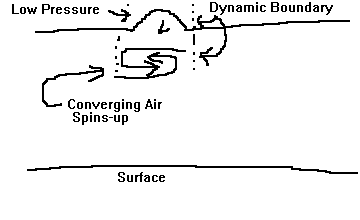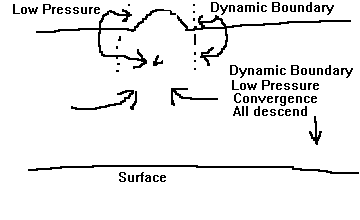A further quandary is how the tornado manages to make a connection between the cloud and the ground so quickly. The problem becomes clear if we calculate how long it would take motion to diffuse over the distance from cloud to ground. Momentum in air (or any other fluid) diffuses throughout the fluid because of viscosity. Air has low viscosity, which means that the diffusion takes place slowly. The time taken to diffuse is a setting is approximately equal to the square of a characteristic length in the setting divided by viscosity. If in SI units we use 1000m as the characteristic length (cloud to ground distance) and 0.015 as viscosity, the required time is about a year. Even if one were to invoke eddy transport of momentum, so that eddy viscosity would be appropriate to use, the characteristic viscosity is increased to about 5, and a tornado takes a few days to a week to develop. Yet tornadoes connect from cloud to ground in mere minutes.
As we shall see later, there are other ways to complete the connection from cloud to ground. For example, making use of pre-existing vortex connections. Another possibility is that convection drags the motion upward in an updraft, or sinking air drags it down from the cloud. There are observations that run counter to each of these suggestions. For example, if an updraft draws the motion from ground to cloud, why is that that radar indicates the tornado signature first in the cloud? If downdrafts bring the motion to the surface, then survivors of tornadoes should have noticed an extreme warmth in the descending air (perhaps 140F!). No one, to my knowledge, has ever reported such a thing.
People have recognized for decades that one possible solution to this quandary is to suppose that a secondary flow, an air flow that arises because of the original primary flow, provides rapid transport of the vortex. The prototype example of a secondary flow is that which occurs in a cup of stirred tea. The primary motion in this case is the rotation of the bulk of the tea which resulted from stirring. This is approximately the rotation of a solid body. The secondary flow results from the bowl-shaped free surface of tea and friction with the bottom and sides of the cup; wherein tea flows toward the center of the cup along the bottom, then up at the center and out to the side of the cup along the surface of the tea. This flow is what piles tea leaves in the center of the cup, and, although it makes a fine example, and is always trotted out to help explain the sorts of secondary flows expected in a tornado, it is quite unlike a secondary flow that creates a tornado vortex. The flow in the tea cup takes place in a tightly bound volume; whereas the tornado vortex occurs in an apparently unbounded atmosphere.

A better example, known as a dynamic pipe, I explain in the following four panels of drawings. Panel 1 shows the initial situation. A low pressure region develops in a rotating cloud, probably because of buoyancy. However, air from the surrounding cloud cannot fill this region. The cloud is spinning, and air cannot converge further because of the excessive centripetal acceleration that would require.

Panel 2 shows that the easiest route is to draw air from below. However, if the air below the cloud is also spinning, even if it is doing so more slowly than in the cloud, the convergence will soon cause a rapid spin of the air and will shut off this lateral flow.

Panel 3 shows that the low pressure, rapidly spinning tube of air, and convergence have all descended. This process continues at ever lower levels.

In Panel 4 the dynamic pipe, convergence and low pressure have descended very close to the surface. Because air cannot flow out of the ground surface, there is an imaginary image of the low pressure just below the ground surface that "sucks" the open end of the dynamic pipe rapidly to the ground and closes its open end. The entire sequence can happen in minutes. Remember, this sequence of events requires a very special set of conditions to start it. There must be a continual source of suction from above (instability and buoyancy of the air) and enough ambient rotation of the air to shut off horizontal convergence of air quickly.